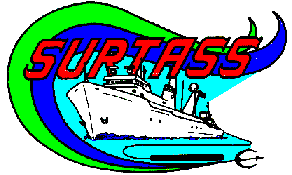




 The Surveillance Towed Array Sensor System (SURTASS) is an element of the Integrated Undersea Surveillance System, providing mobile detection, tracking, and reporting of submarine contacts at long range. SURTASS was developed and deployed in the early 1980s as the mobile, tactical arm of the IUSS, providing long range detection and cuing for tactical weapons platforms against both diesel and nuclear powered
submarines. With the SOSUS Arrays being placed in a standby status
(data available but not continuously monitored), SURTASS must provide
the undersea surveillance necessary to support regional conflicts and
sea lane protection.
The Surveillance Towed Array Sensor System (SURTASS) is an element of the Integrated Undersea Surveillance System, providing mobile detection, tracking, and reporting of submarine contacts at long range. SURTASS was developed and deployed in the early 1980s as the mobile, tactical arm of the IUSS, providing long range detection and cuing for tactical weapons platforms against both diesel and nuclear powered
submarines. With the SOSUS Arrays being placed in a standby status
(data available but not continuously monitored), SURTASS must provide
the undersea surveillance necessary to support regional conflicts and
sea lane protection.
Ocean Surveillance Ships conduct submarine hunting patrols and counter drug missions. Ships on Submarine hunting duty employ a towed sonar array. Data is transmitted from the ship to an acoustic processing site ashore via satellite. Stalwart class ships were designed to search for foreign submarines. Several have since been assigned as drug interdiction forces. Victorious class ships are built on a Small Waterplane Twin Hull (SWATH) design for stability at low speeds and in rough waters.
Existing baseline SURTASS suites on monohull-hull T-AGOS ships are being deactivated and T-AGOS 19 and 23 class vessels will replace them. The new vessels feature a small water-plane area twin hull (SWATH) design which provides quieting to enhance performance of the reduced diameter array and greater stability in high sea states for the LFA source array. T-AGOS 23 class ships are larger than T-AGOS 19 ships in order to handle the larger and heavier equipment for the LFA system. Original procurement was projected for up to five T-AGOS 23 class ships; the current program is in flux, but will certainly be more modest, due to extensive delays by shipyard problems with construction of the $60,000,000 lead ship whose delivery has slipped to the end of 1998. The SURTASS block upgrade will back-fit into T-AGOS 19 (currently with a baseline system) and will be the sensor suite (passive receive only) for T-AGOS 20 through 22. Eventually T-AGOS 19 through 22 will also have a capability to receive and process bistatic LFA signals.The current, or baseline, sensor is a long array of hydrophones towed by a dedicated non-combatant ship designated T-AGOS. There are two upgrades.
Other SURTASS development efforts include: twin-line array processing, improved detection and classification/passive automation to counter quieter threats; additional signal processing and bi-static active capability; integrated active and passive operations; improved Battle Group support; and improved information processing.
SURTASS has experienced recent passive and active success against diesel submarines operating in shallow water. A prototype twin-line SURTASS array was tested during 1996 in a variety of locations around the world, with positive results. It is far superior to any other shallow-water passive towed-array system. SURTASS processing is being transferred to the AN/SQQ-89 towed-array sonar system to provide an immediate increase in detection capability without the need to modify or procure additional wet-end hardware. The minimum fleet requirement of eight SURTASS ships is funded through the FYDP.
Functional improvements are delivered to the Fleet in software "Builds". Build #1 (FY 95) includes source-set formulation and analysis tools, automated line trackers and nuclear source auto- detector. Build #2 (FY 96) includes wideband energy trackers, wideband/narrowband feature association, and diesel Full Spectrum Processing (FSP). Build #3 (FY 97) includes automated localization and tracking, diesel automated detection and twin-line integration.
SURTASS is a non-military program staffed by civilian "operations personnel" contracted to SPAWAR, who operate and maintain the mission equipment under the operational command of Commander Undersea Surveillance (CUS). The SURTASS equipment is primarily deployed in Auxiliary Oceanographic Survey ships (T-AGOS) that are staffed by civilian mariners under contract to the Military Sealift Command (MSC). The Military Sealift Command operates ships manned by civilian crews and under the command of a civilian master. These ships, indicated by the blue and gold bands on their stack, are "United States Naval Ships" vice "United States Ships" as is the case of commissioned ships.
SURTASS is comprised of a worldwide network of ship and shore systems designed to do undersea surveillance. This complex network of mission dedicated equipment and systems routinely requires replenishment, upkeep, maintenance, and service to be accomplished by IOSC resident personnel. To this end, several "remote" facilities have been established to provide "bases" of operation in support of the SURTASS mission. Although operations are based in Norfolk Virginia, SURTASS routinely operates from ports in Glasgow Scotland, Rota Spain, Yokohama Japan, Pearl Harbor Hawaii, Port Huneme California, and many other ports of opportunity. SURTASS's Pacific operations are coordinated from the IUSS Operations Support Detachment (IOSD) located at the facility within NRaD Activity, Pacific in Pearl City, Hawaii. SURTASS is greatly reducing costs by consolidating logistics support, using Non-Developmental Items and commercial hardware, and increasing operator efficiency through computer aided detection and classification processing.
